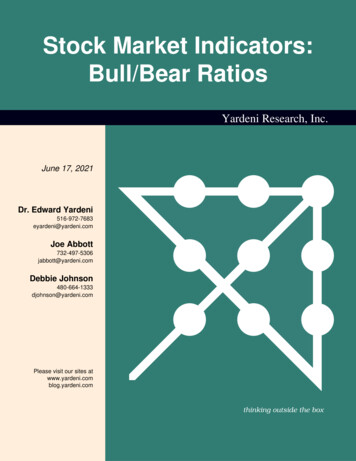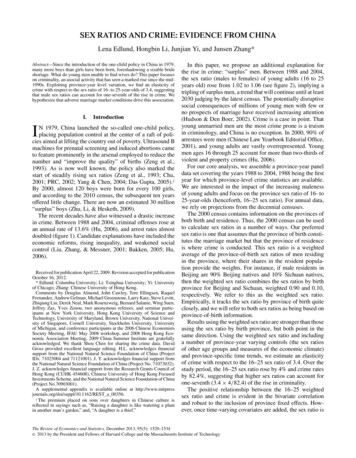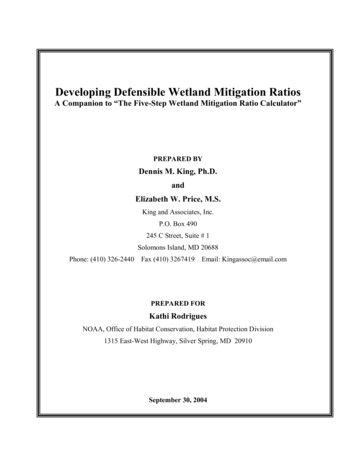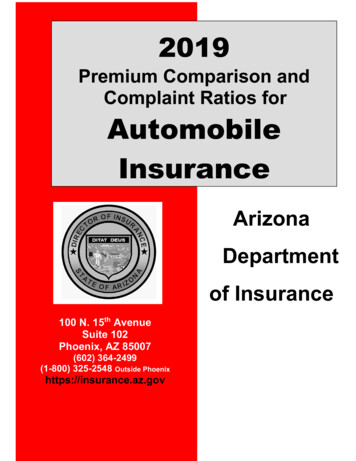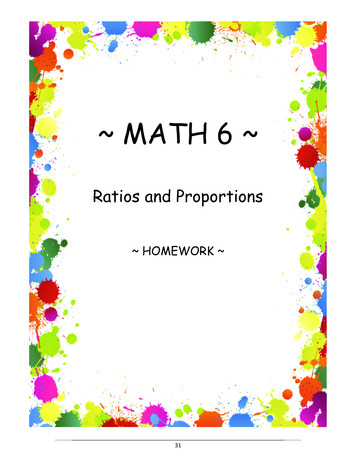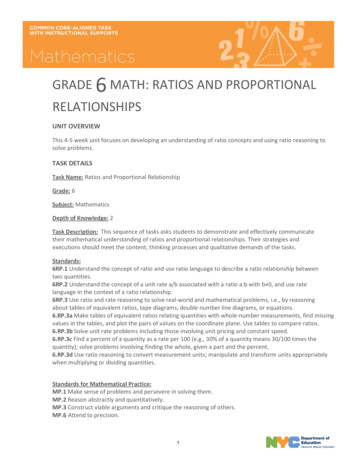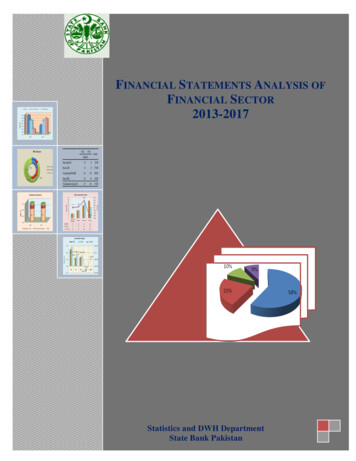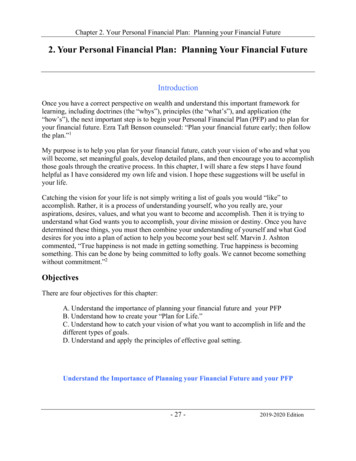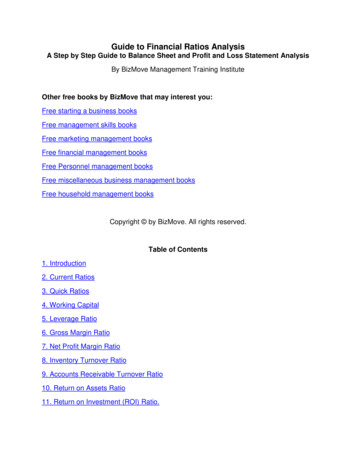
Transcription
Guide to Financial Ratios AnalysisA Step by Step Guide to Balance Sheet and Profit and Loss Statement AnalysisBy BizMove Management Training InstituteOther free books by BizMove that may interest you:Free starting a business booksFree management skills booksFree marketing management booksFree financial management booksFree Personnel management booksFree miscellaneous business management booksFree household management booksCopyright by BizMove. All rights reserved.Table of Contents1. Introduction2. Current Ratios3. Quick Ratios4. Working Capital5. Leverage Ratio6. Gross Margin Ratio7. Net Profit Margin Ratio8. Inventory Turnover Ratio9. Accounts Receivable Turnover Ratio10. Return on Assets Ratio11. Return on Investment (ROI) Ratio.
12. Understanding Financial Statements:1. IntroductionIf you are not fully familiar with the structure of financial statements please read first thebonus guide: Understanding Financial Statements.What is ratio analysis? The Balance Sheet and the Statement of Income are essential,but they are only the starting point for successful financial management. Apply RatioAnalysis to Financial Statements to analyze the success, failure, and progress of yourbusiness.Ratio Analysis enables the business owner/manager to spot trends in a business and tocompare its performance and condition with the average performance of similarbusinesses in the same industry. To do this compare your ratios with the average ofbusinesses similar to yours and compare your own ratios for several successive years,watching especially for any unfavorable trends that may be starting. Ratio analysis mayprovide the all-important early warning indications that allow you to solve your businessproblems before your business is destroyed by them.Go to TopBalance Sheet Ratio AnalysisImportant Balance Sheet Ratios measure liquidity and solvency (a business's ability topay its bills as they come due) and leverage (the extent to which the business isdependent on creditors' funding). They include the following ratios:Liquidity RatiosThese ratios indicate the ease of turning assets into cash. They include the CurrentRatio, Quick Ratio, and Working Capital.Go to Top2. Current RatiosThe Current Ratio is one of the best known measures of financial strength. It is figuredas shown below:Current Ratio
Total Current AssetsTotal Current LiabilitiesThe main question this ratio addresses is: "Does your business have enough currentassets to meet the payment schedule of its current debts with a margin of safety forpossible losses in current assets, such as inventory shrinkage or collectable accounts?"A generally acceptable current ratio is 2 to 1. But whether or not a specific ratio issatisfactory depends on the nature of the business and the characteristics of its currentassets and liabilities. The minimum acceptable current ratio is obviously 1:1, but thatrelationship is usually playing it too close for comfort.If you decide your business's current ratio is too low, you may be able to raise it by:Paying some debts.Increasing your current assets from loans or other borrowings with a maturity of morethan one year.Converting non-current assets into current assets.Increasing your current assets from new equity contributions.Putting profits back into the business.Go to Top3. Quick RatiosThe Quick Ratio is sometimes called the "acid-test" ratio and is one of the bestmeasures of liquidity. It is figured as shown below:Quick Ratio Cash Government Securities ReceivablesTotal Current LiabilitiesThe Quick Ratio is a much more exacting measure than the Current Ratio. By excludinginventories, it concentrates on the really liquid assets, with value that is fairly certain. Ithelps answer the question: "If all sales revenues should disappear, could my businessmeet its current obligations with the readily convertible quick' funds on hand?"An acid-test of 1:1 is considered satisfactory unless the majority of your "quick assets"are in accounts receivable, and the pattern of accounts receivable collection lags behindthe schedule for paying current liabilities.Go to Top
4. Working CapitalWorking Capital is more a measure of cash flow than a ratio. The result of thiscalculation must be a positive number. It is calculated as shown below:Working Capital Total Current Assets - Total Current LiabilitiesBankers look at Net Working Capital over time to determine a company's ability toweather financial crises. Loans are often tied to minimum working capital requirements.A general observation about these three Liquidity Ratios is that the higher they are thebetter, especially if you are relying to any significant extent on creditor money to financeassets.Go to Top5. Leverage RatioThis Debt/Worth or Leverage Ratio indicates the extent to which the business is relianton debt financing (creditor money versus owner's equity):Debt/Worth Ratio Total LiabilitiesNet WorthGenerally, the higher this ratio, the more risky a creditor will perceive its exposure inyour business, making it correspondingly harder to obtain credit.Go to TopIncome Statement Ratio AnalysisThe following important State of Income Ratios measure profitability:6. Gross Margin RatioThis ratio is the percentage of sales dollars left after subtracting the cost of goods soldfrom net sales. It measures the percentage of sales dollars remaining (after obtaining ormanufacturing the goods sold) available to pay the overhead expenses of the company.Comparison of your business ratios to those of similar businesses will reveal the relativestrengths or weaknesses in your business. The Gross Margin Ratio is calculated asfollows:Gross Margin Ratio
Gross ProfitNet Sales(Gross Profit Net Sales - Cost of Goods Sold)Go to Top7. Net Profit Margin RatioThis ratio is the percentage of sales dollars left after subtracting the Cost of Goods soldand all expenses, except income taxes. It provides a good opportunity to compare yourcompany's "return on sales" with the performance of other companies in your industry. Itis calculated before income tax because tax rates and tax liabilities vary from companyto company for a wide variety of reasons, making comparisons after taxes much moredifficult. The Net Profit Margin Ratio is calculated as follows:Net Profit Margin Ratio Net Profit Before TaxNet SalesGo to TopManagement RatiosOther important ratios, often referred to as Management Ratios, are also derived fromBalance Sheet and Statement of Income information.8. Inventory Turnover RatioThis ratio reveals how well inventory is being managed. It is important because themore times inventory can be turned in a given operating cycle, the greater the profit.The Inventory Turnover Ratio is calculated as follows:Inventory Turnover Ratio Net SalesAverage Inventory at CostGo to Top9. Accounts Receivable Turnover Ratio
This ratio indicates how well accounts receivable are being collected. If receivables arenot collected reasonably in accordance with their terms, management should rethink itscollection policy. If receivables are excessively slow in being converted to cash, liquiditycould be severely impaired. The Accounts Receivable Turnover Ratio is calculated asfollows:Net Credit Sales/Year Daily Credit Sales365 Days/YearAccounts Receivable Turnover (in days) Accounts ReceivableDaily Credit SalesGo to Top10. Return on Assets RatioThis measures how efficiently profits are being generated from the assets employed inthe business when compared with the ratios of firms in a similar business. A low ratio incomparison with industry averages indicates an inefficient use of business assets. TheReturn on Assets Ratio is calculated as follows:Return on Assets Net Profit Before TaxTotal AssetsGo to Top11. Return on Investment (ROI) Ratio.The ROI is perhaps the most important ratio of all. It is the percentage of return onfunds invested in the business by its owners. In short, this ratio tells the owner whetheror not all the effort put into the business has been worthwhile. If the ROI is less than therate of return on an alternative, risk-free investment such as a bank savings account,the owner may be wiser to sell the company, put the money in such a savingsinstrument, and avoid the daily struggles of small business management. The ROI iscalculated as follows:Return on Investment
Net Profit before TaxNet WorthThese Liquidity, Leverage, Profitability, and Management Ratios allow the businessowner to identify trends in a business and to compare its progress with the performanceof others through data published by various sources. The owner may thus determine thebusiness's relative strengths and weaknesses.Go to Top12. Understanding Financial Statements:Financial Statements analysis record the performance of your business and allow you todiagnose its strengths and weaknesses by providing a written summary of financialactivities. There are two primary financial statements: the Balance Sheet and theStatement of Income.The Balance SheetFinancial statement analysis looks first at the balance sheet. The Balance Sheetprovides a picture of the financial health of a business at a given moment, usually at theclose of an accounting period. It lists in detail those material and intangible items thebusiness owns (known as its assets) and what money the business owes, either to itscreditors (liabilities) or to its owners (shareholders' equity or net worth of the business).Assets include not only cash, merchandise inventory, land, buildings, equipment,machinery, furniture, patents, trademarks, and the like, but also money due fromindividuals or other businesses (known as accounts or notes receivable).Liabilities are funds acquired for a business through loans or the sale of property orservices to the business on credit. Creditors do not acquire business ownership, butpromissory notes to be paid at a designated future date.Shareholders' equity (or net worth or capital ) is money put into a business by itsowners for use by the business in acquiring assets.At any given time, a business's assets equal the total contributions by the creditors andowners, as illustrated by the following formula for the Balance Sheet:Assets Liabilities Net worthThis formula is a basic premise of accounting. If a business owes more money tocreditors than it possesses in value of assets owned, the net worth or owner's equity ofthe business will be a negative number.
The Balance Sheet is designed to show how the assets, liabilities, and net worth of abusiness are distributed at any given time. It is usually prepared at regular intervals;e.g., at each month's end, but especially at the end of each fiscal (accounting) year.By regularly preparing this summary of what the business owns and owes (the BalanceSheet), the business owner/manager can identify and analyze trends in the financialstrength of the business. It permits timely modifications, such as gradually decreasingthe amount of money the business owes to creditors and increasing the amount thebusiness owes its owners.All Balance Sheets contain the same categories of assets, liabilities, and net worth.Assets are arranged in decreasing order of how quickly they can be turned into cash(liquidity). Liabilities are listed in order of how soon they must be repaid, followed byretained earnings (net worth or owner's equity).The categories and format of the Balance Sheet are established by a system known asGenerally Accepted Accounting Principles (GAAP). The system is applied to allcompanies, large or small, so anyone reading the Balance Sheet can readilyunderstand the story it tells.
Balance Sheet CategoriesAssets and liabilities are broken down into categories as described as follows:.Assets: An asset is anything the business owns that has monetary value.Current Assets include cash, government securities, marketable securities, accountsreceivable, notes receivable (other than from officers or employees), inventories,prepaid expenses, and any other item that could be converted into cash within one yearin the normal course of business.Fixed Assets are those acquired for long-term use in a business such as land, plant,equipment, machinery, leasehold improvements, furniture, fixtures, and any other itemswith an expected useful business life measured in years (as opposed to items that willwear out or be used up in less than one year and are usually expensed when they arepurchased). These assets are typically not for resale and are recorded in the BalanceSheet at their net cost less accumulated depreciation.
Other Assets include intangible assets, such as patents, royalty arrangements,copyrights, exclusive use contracts, and notes receivable from officers and employees.Liabilities: Liabilities are the claims of creditors against the assets of the business(debts owed by the business).Current Liabilities are accounts payable, notes payable to banks, accrued expenses(wages, salaries), taxes payable, the current portion (due within one year) of long-termdebt, and other obligations to creditors due within one year.Long-Term Liabilities are mortgages, intermediate and long-term bank loans, equipmentloans, and any other obligation for money due to a creditor with a maturity longer thanone year.Net Worth is the assets of the business minus its liabilities. Net worth equals theowner's equity. This equity is the investment by the owner plus any profits or minus anylosses that have accumulated in the business.The Statement of IncomeThe second primary report included in a business's Financial Statement is theStatement of Income. The Statement of Income is a measurement of a company's salesand expenses over a specific period of time. It is also prepared at regular intervals(again, each month and fiscal year end) to show the results of operating during thoseaccounting periods. It too follows Generally Accepted Accounting Principles (GAAP)and contains specific revenue and expense categories regardless of the nature of thebusiness.Statement of Income CategoriesThe Statement of Income categories are calculated as described below:Net Sales (gross sales less returns and allowances)Less Cost of Goods Sold (cost of inventories)Equals Gross Margin (gross profit on sales before operating expenses)Less Selling and Administrative Expenses (salaries, wages, payroll taxes and benefits,rent, utilities, maintenance expenses, office supplies, postage, automobile/vehicleexpenses, insurance, legal and accounting expenses, depreciation)Equals Operating Profit (profit before other non-operating income or expense)Plus Other Income (income from discounts, investments, customer charge accounts)Less Other Expenses (interest expense)Equals Net Profit (or Loss) before Tax (the figure on which your tax is calculated)Less Income Taxes (if any are due)
Equals Net Profit (or Loss) After TaxCalculating the Cost of Goods SoldCalculation of the Cost of Goods Sold category in the Statement of Income (or Profitand-Loss Statement as it is sometimes called) varies depending on whether thebusiness is retail, wholesale, or manufacturing. In retailing and wholesaling, computingthe cost of goods sold during the accounting period involves beginning and endinginventories. This, of course, includes purchases made during the accounting period. Inmanufacturing it involves not only finished-goods inventories, but also raw materialsinventories, goods-in-process inventories, direct labor, and direct factory overheadcosts.Regardless of the calculation for Cost of Goods Sold, deduct the Cost of Goods Soldfrom Net Sales to get Gross Margin or Gross Profit. From Gross Profit, deduct generalor indirect overhead, such as selling expenses, office expenses, and interest expenses.to calculate your Net Profit. This is the final profit after all costs and expenses for theaccounting period have been deducted.Go to Top
Analysis to Financial Statements to analyze the success, failure, and progress of your business. Ratio Analysis enables the business owner/manager to spot trends in a business and to compare its performance and condition with the average performance of similar businesses in the same ind
